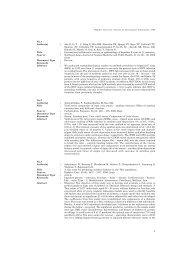Faculty of Science - Mahidol University
Faculty of Science - Mahidol University
Faculty of Science - Mahidol University
You also want an ePaper? Increase the reach of your titles
YUMPU automatically turns print PDFs into web optimized ePapers that Google loves.
294<br />
A CYTOLOGICAL STUDY OF BLACK FLY<br />
SIMULIUM SIAMENSE (DIPTERA: SIMULIIDAE)<br />
(NO. 765)<br />
Unchalee Lualon, Chaliow Kuvangkadilok and Visut Baimai<br />
Department <strong>of</strong> Biology, <strong>Faculty</strong> <strong>of</strong> <strong>Science</strong>, Mahidl <strong>University</strong>,<br />
Bangkok, 10400<br />
The polytene chromosomes <strong>of</strong> the Simulium siamensis from<br />
7 sites collected in western, northern Thailand were analyzed. At<br />
the least two cytotypes are recognized based primarily on two fixed<br />
inversions (IS-2 and IS-2,3) in the IS arm. Cytotype A represent<br />
two populations from Kaeng Krachan National Park, Petchaburi<br />
province. All males <strong>of</strong> cytotype A were IS-2 homozygotes (IS2-2)<br />
whereas all females were IS2,3 heterozygotes (IS-st/2,3). Therefore<br />
there is indication <strong>of</strong> sex-linkage associated with inversion sequence<br />
in this cytotype. Cytotype B consisting <strong>of</strong> three populations from<br />
Mae Hong Son province and two populations from Chaiyaphum<br />
province, showed nine floating inversions (IS-1, IS-4, IS-5, IL-1,<br />
IIL-2, IIL-3, IIIS-1 and IIIL-1) in five chromosome arms with low<br />
frequencies ranging from 0.01-0.27. All inversions in all populations<br />
except for the Huay Yuak population conformed to Hardy-Weinberg<br />
equilibrium (p>0.05).<br />
(14 th International Symposium on Genetics, Genetics: Fromn Basics<br />
to Molecular Technology: March 11-13, 2005: BRT.)<br />
CYTOGENETICS OF BLACK FLY SIMULIUM<br />
TANI (DIPTERA : SIMULIIDAE) FROM<br />
THAILAND. (NO. 766)<br />
Ubon Tangkawanit 1 , Chaliow Kuvangkadilok 1 , Peter H. Adler 2<br />
and Visut Baimai 1<br />
1 Depart ment <strong>of</strong> Biology, <strong>Faculty</strong> <strong>of</strong> <strong>Science</strong>, <strong>Mahidol</strong> <strong>University</strong>,<br />
Bangkok, Thailand, 10400; 2 Department <strong>of</strong> Entomology,<br />
Clemson <strong>University</strong>, South Carolina, USA.<br />
The plytene chromosomes <strong>of</strong> the Simulium tani from 5 sites<br />
collected in northern eastern and southern Thailand were analyzed.<br />
At least two cytotypes are recognized based primarily on one fixed<br />
inversion (IIIL-5,6) in the IIIL arm. Cytotype A represents one<br />
population from Morkpha waterfall, Doi Suthep-Pui National Park,<br />
Chiang Mai province which is monomorphic. S. tani cytotype B<br />
consists <strong>of</strong> one population from southern Thailand (Muang Tuad<br />
waterfall, Surat Thani province) and three populations from eastern<br />
Thailand (Chanthaburi and Rayong provinces). All individuals <strong>of</strong><br />
cytotype B are homozygous for IIIL-5,6. They also showed six<br />
floating inversion (IS-5, IS-6, IL-1, IIP-1, IIIL-7, and IIIL-10) in<br />
five chromosome arms with low frequencies ranging from 0.02-0.43.<br />
All inversion in all populations except for the Muang Tuad<br />
population conformed to Hardy-weinberg equilibrium (p>0.05).<br />
(14 th International Symposium on Genetics, Genetics: Fromn Basics<br />
to Molecular Technology: March 11-13, 2005: BRT.)<br />
<strong>Faculty</strong> <strong>of</strong> <strong>Science</strong><br />
CYTOTAXONOMY OF BLACK FLIES (DIPTERA:<br />
SIMULIIDAE) FROM THAILAND (NO. 767)<br />
Chaliow Kuvangkadilok 1 Chainarong Boonkemtong 2 Suwannee<br />
Phayuhasena 1 and Visut Baimai 1<br />
1 Department <strong>of</strong> Biology , <strong>Faculty</strong> <strong>of</strong> <strong>Science</strong> , <strong>Mahidol</strong> <strong>University</strong>,<br />
Bangkok, 10400; 2 National Center for Genetic Engineering and<br />
Biotechnology 113 Thailand <strong>Science</strong> Park, Phaholyothin Rd.,<br />
Klong 1 , Klong Luang Pathumthani, 12120.<br />
Polytene chromosomes <strong>of</strong> eighteen Simulium species<br />
belonging to eight species-groups within four subgenera, i.e.,<br />
subgenera Gomphostilbia, Nevermannia, Simulium and<br />
Montisimulium are described and the standard maps for the speciesgroups<br />
are presented. All Simulium species have a haploid number<br />
<strong>of</strong> three chromosomes (n=3) with decreasing in length from<br />
chromosomes to chromosomes ²²². The banding patterns and the<br />
positions <strong>of</strong> landmarks <strong>of</strong> the polytene chromosomes are species<br />
specific which can be used to identify the species especially the<br />
morphologically similar species. Eight species have low frequencies<br />
<strong>of</strong> paracentric inversions with no indication <strong>of</strong> sex linkage. This<br />
result showed no evidence <strong>of</strong> a sibling species complex within any<br />
taxon. Further cytological studies should provide more useful<br />
knowledge <strong>of</strong> species complexes <strong>of</strong> these Simulium species.<br />
(14 th International Symposium on Genetics, Genetics: Fromn Basics<br />
to Molecular Technology: March 11-13, 2005: BRT.)<br />
SPECIES DIVERSITY, DISTRIBUTION AND<br />
PARASITES OF BLACK FLY LARVAE (DIPTERA:<br />
SIMULIIDAE) IN NORTHERN THAILAND (NO. 768)<br />
Sanae Jitklang 1 Chailow Kuvangkadilok 1 , Peter H.Adler 2 and<br />
Visut Baimai 1<br />
1 Department <strong>of</strong> Biology , <strong>Faculty</strong> <strong>of</strong> <strong>Science</strong> , <strong>Mahidol</strong> <strong>University</strong>,<br />
Bangkok, 10400; 2 Department <strong>of</strong> Entomology, Clemson<br />
<strong>University</strong>, South Carolina, USA.<br />
Species diversity , species distribution and parasites <strong>of</strong> black<br />
fly larvae collected from 10 northern province <strong>of</strong> Thailand in rainy<br />
season, winter and summer are presented. Based on the external<br />
morphological characters and polytene chromosome analyses, a total<br />
<strong>of</strong> 27 black fly species was identified. The abundance <strong>of</strong> twenty-six<br />
Simulium species was found in winter. However, twenty-four and<br />
twenty-three species were also presented in rainy season and summer,<br />
respectively. Additionally, these species had different distribution.<br />
Some species werw widely distributed in many provinces while a<br />
few species was restricted to one province. Moreover, preliminary<br />
study showed three types <strong>of</strong> parasites, i., nematodes, microsporidia<br />
and fungus in some Simulium larvae.<br />
(14 th International Symposium on Genetics, Genetics: Fromn Basics<br />
to Molecular Technology: March 11-13, 2005: BRT.)<br />
PDF created with FinePrint pdfFactory Pro trial version http://www.pdffactory.com
















